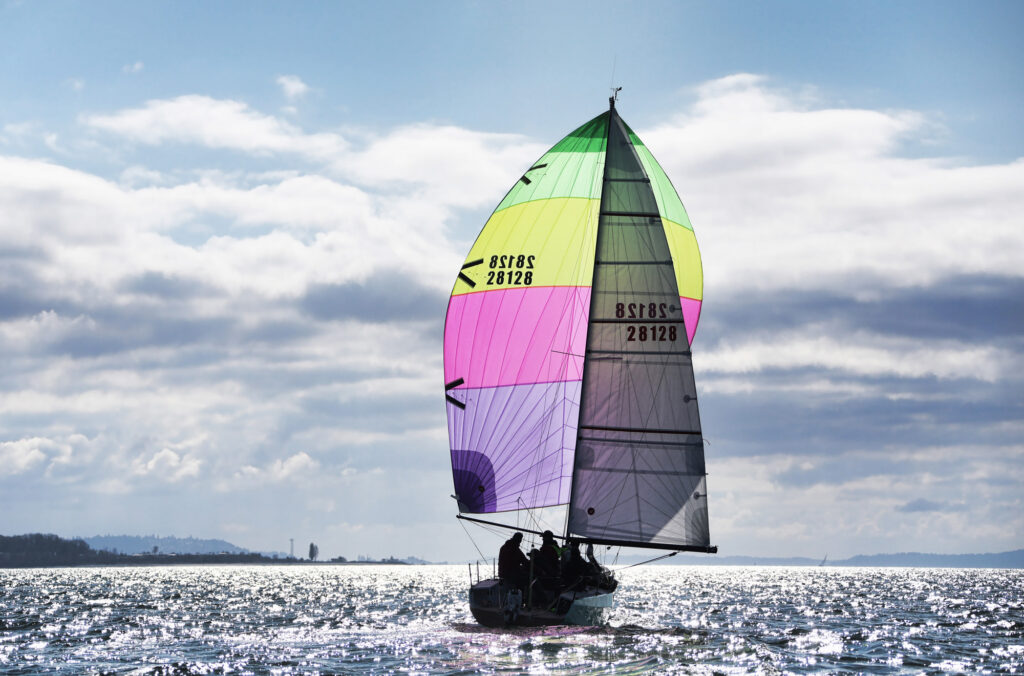
March means different things to different people. For some, it is the deepest part of winter, right before the days start getting noticeably longer and life returns to the afternoons; to others, it is the height of ski season with fantastic powder days, and to a foolhardy few, it’s time to shovel snow off the decks and take the boats out to race.
The Center Sound Series has been the first major regatta of the spring season for decades, and while there have been some minor and major tweaks in recent years, it remains a staple of the Seattle racing calendar. Corinthian Yacht Club of Seattle are the folks to blame for the event’s timing, which is hosted in the early season to capitalize on the windy conditions that the early spring has in store. This year we have 75 entries covering the spectrum from the lightning-fast TP52s to a highly competitive fleet of 20- to 30-footers in class one, all itching to start the season with good results.
The first race of the three-part series is Blakely Rock, so-named after the landmark rock outcropping that provides the turning point for the course. Located at the entrance to Eagle Harbor on Bainbridge Island, the jagged rocks have generated countless dollars of bottom repair work for local boat yards over the years. On Saturday, March 4, the race was set up for a unique weather system consisting of a stationary low-pressure system just off the mouth of the Straits of Juan De Fuca. The resulting pushing and pulling of air around the mountains left everything volatile throughout western Washington, with no notable pressure gradient to drive anything resembling steady wind.
So, as expected, the breeze on the race morning was shifty and puffy, accompanied by heavy rain. Nevertheless, racing got underway on time, and things seemed reasonably manageable as the fleet reached toward the rocks in a deceptively steady southeasterly. Still, as boats passed out from under the Magnolia bluff, the puffs started working their way across the bay from the city. Going from sailing in 8-knot winds to being suddenly on your side in 20-knot ones, combined with the shallow water and hazards of the approaching rocks, set the stage for some white-knuckle moments. But, all in all, the fleet made it around the rocks in one piece.
The next leg of the race saw 90-degree shifting puffs coming out of Elliott Bay that led to more than a handful of wipeouts. The high-traffic kite reach turned into a game of chutes and ladders as boats were forced to bear off in the puffs and reach up in the lulls to hold their position in the pack. The joke onboard our boat was that it was a steady zero to 20-knot east-southwesterly, but a great start to the 2024 racing season.
The week between the first and second races was eventful. Snow flurries throughout Puget Sound and high wind forecasts were on the horizon. The excitement diminished slightly as the weekend neared and the forecast began to settle into what was meant to be a straightforward day of sailing in a receding southerly wind.
The morning of March 11th started according to the script, with a 10- to 13-knot southerly, in line with the forecast. As the boats were setting up for the day’s activities, the race committee announced their intended course, sending the fleet southward, this time around Blake Island, then over to the Duwamish Head marker, and the back to Shilshole Bay to finish. A few boats were surprised, as the traditional racecourse for this weekend takes the fleet to the north and around Scatchet Head. Updates in sailing instructions made back in 2022 changed the regatta, so that the race committee can run whatever course they feel is best suited for the day’s conditions and they did.
As the fleets got underway, the wind began to get light, then build, then get soft again, still all in line with the forecast for the day. Most boats followed the tried-and-true approach of sailing up to the beach at West Point and punching across to the Bainbridge Island shoreline. A strong ebb tide resulted in a tight-packed fight for shallow water to stay out of the current, making for some high-stress moments in the shifting conditions. The race felt all too familiar as the track took the fleet right past the same Blakely Rock they sailed around last weekend, but this time we continued southward.
Things got interesting as the fleet worked their way around the island, with the wind cutting out and filling from the west, south, and east simultaneously. At one point, boats sailed on spinnakers but headed in three directions thanks to the shifting breeze. So far, someone could argue that the wind was following the forecast to the letter, but then on the final leg of the race back to Shilshole Bay, the northwesterly filled in. It was a bit of a “rich got richer” moment, with the leading boats first stepping into the filling breeze and leaving those behind in the dust. As often as it seems, the new wind fills from behind, and the trailing boats catch up; it was a good reminder that sometimes it works the other way around.
The third and final race of the Center Sound is scheduled for March 25 and is sure to be welcomed with hopefully warmer temperatures and a more consistent breeze! Check back for an update on that final race and more upcoming events from Sloop Tavern Yacht Club and Seattle Yacht Club throughout the Salish Sea. We have a fantastic summer of racing to look forward to.


